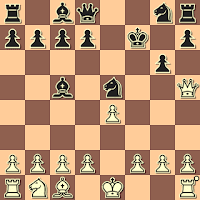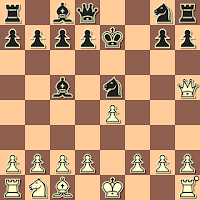Long time readers of this blog - or those who have browsed earlier posts - may recall that I occasionally examine opening lines or historical games to see if they might have been the inspiration of Alonzo Wheeler Jerome's Gambit. I have not yet found any information from Jerome, himself, but the search is enjoyable, nonetheless.
Similarly, while I have posted a number of games and links to videos featuring American Grandmaster Hikaru Nakamura playing the Jerome Gambit, I have not learned what originally interested him in 1.e4 e4 2.Nf3 Nc6 3.Bc4 Bc5 4.Bxf7+. (I guessed that he had seen Grandmaster Aman Hambleton's hilarious video, and decided to get in on the fun.)
Recently, Yury V. Bukayev sent me a couple of bullet games played betwen top GM Maxime Vachier-Lagrave (" LyonBeast ") and top GM Hikaru Nakamura (" Hikaru "), with the intriguing theory that might explain Nakamura's interest in the Jerome.
Modern chess matches, especially those played online, often feature games played at a faster time limit, either as part of the conflict itself (e.g. some games played at a classical limit, plus some played at a rapid limit, plus some games played at blitz speed) or as a tie-break mechanism. Occasionally, even bullet games - 1 minute per game, with a small increment per move - make their appearance.
With that introduction, let's take a look at the first game. It is a Vienna Game, the Hamppe-Muzio variation.
LyonBeast - Hikaru
1 1 bullet, The Chess.com Grandmaster Blitz Battle Championship, Semifinal, Game 29, 2016
1.e4 e5 2.Nc3 Nc6 3.f4 exf4 4.Nf3 g5 5.Bc4 g4 6.O-O gxf3 7.Bxf7+
White has already sacrificed a Knight, now he sacrifices a Bishop to draw the enemy King to the dangerous f-file.
In a game with plenty of time to think and analyze, this move would be suicidal. (Stockfish 14 evaluates Black as being almost a Rook ahead.) In a 1-minute game, however, it is shocking enough to be playable - even between grandmasters.
As GM Nakamura and FM Bruce Harper wrote in their book, Bullet Chess One Minute to Mate (2009)
It is important to realize that bullet chess is not really about "truth," to the extent that some chess players use the term to refer to the objectively best moves, but rather whatever works. Bullet chess won't often help you in your search for "chess truth," although it will certainly help you learn how to play chess more quickly! But bullet chess will teach you a lot about chess psychology, as there is always a reason that any particular move is played it may not be a good reason, and it may not have much to do with the actual position, but there is always a reason.
Where did GM Vachier-Lagrave come across such a sacrificial idea? It is possible he just thought it up himself. It is also possible that he was familiar with a couple of earlier games played in Lithuania. Both transpose to the game we are considering.
Narmontas, Matas - Rimeikis, Andrius, LTU-ch U18, 2009: 1.e4 e5 2.Nc3 Nc6 3.f4 exf4 4.Nf3 g5 5.Bc4 g4 6.O-O gxf3 7.Qxf3 Bh6 8.d4 Nxd4 9.Bxf7+ Kxf7 10.Qh5+ Kg7 11.Bxf4 Bxf4 12.Rxf4 Nh6 13.Qe5+ Kg8 14.Qxd4 d6 15.Nd5 Qg5 16.Raf1 Qe5 17.Qe3 Black resigned
Narmontas, Raimondas - Petraitis, Gintautas, Panevezys op-A, 2009: 1.e4 e5 2.Nc3 Nc6 3.f4 exf4 4.Nf3 g5 5.Bc4 g4 6.O-O gxf3 7.Qxf3 Bh6 8.Bxf7+ Kxf7 9.d4 Nxd4 10.Qh5+ Kg7 11.Bxf4 d6 12.Be5+ dxe5 13.Qf7 checkmate
Raimondas is listed as the coach of Matas; given the 30-year difference in ages, perhaps he is the father, or an uncle. The younger Narmontas played the Bishop sacrifice first; perhaps it was his coach's suggestion, or possibly the coach liked the move and later played it himself.
7...Kxf7 8.Qxf3 Bh6 9.d4
This looks more like a game played 150 - 200 years ago, when wile gambits were regular visitors to the 64 squares.
9...Nxd4
A significant mistake. 9...Kg7 was clearly safer
10.Qh5+ Kg7 11. Bxf4 d6 12. Be5+ Black resigned.
Black's King is in grave danger, and it will cost him his Queen to escape.



























